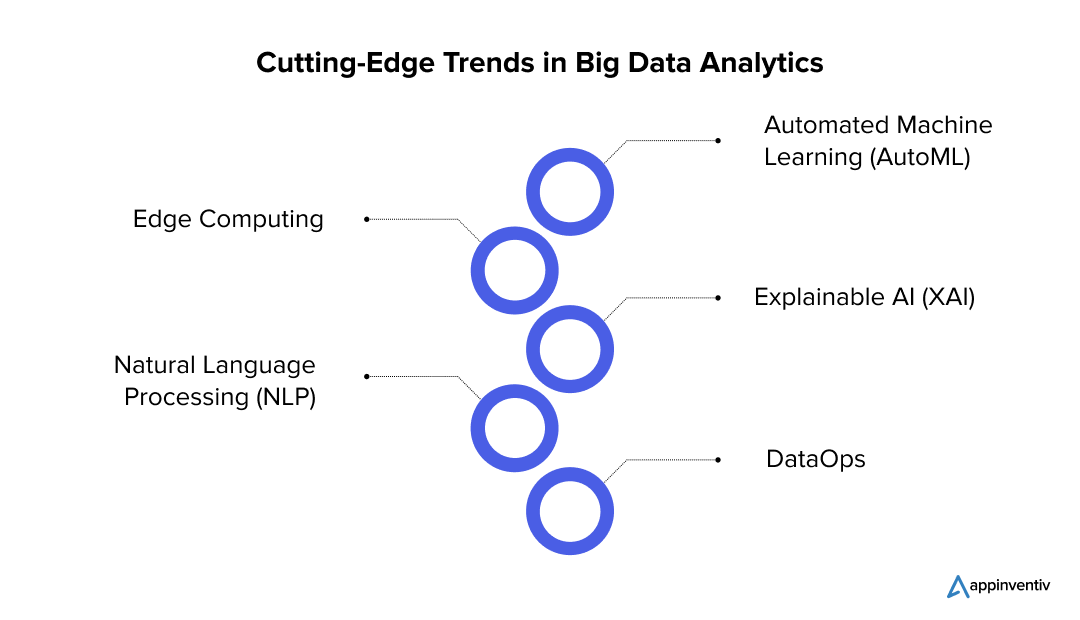- Exploring Big Data Analytics in Oil and Gas: A Quick Overview
- Key Components of Big Data Analytics in the Oil and Gas Industry
- Data Collection and Integration
- Data Storage Solutions
- Data Processing Technologies
- Advanced Analytical Techniques
- Visualization Tools
- Data Security and Governance
- Benefits of Big Data in the Oil and Gas Industry
- Precise Exploration
- Enhanced Production
- Predictive Maintenance
- Safety Improvements
- Drilling and Completion
- Smarter Decisions
- Environmental Management
- Use Cases of Big Data Analytics for the Oil and Gas Industry
- Production Optimization
- Supply Chain Management
- Health, Safety, and Environment (HSE) Compliance
- Reservoir Management
- Energy Consumption Optimization
- Market Analysis and Forecasting
- Enhanced Recovery Techniques
- Cybersecurity
- Real-Life Examples of Big Data Analytics in Oil and Gas
- Pioneering Solutions to Big Data Hurdles in the Oil and Gas Industry
- Shaping Tomorrow: Groundbreaking Trends in Oil and Gas Big Data Analytics
- Automated Machine Learning (AutoML)
- Edge Computing
- Explainable AI (XAI)
- Natural Language Processing (NLP)
- DataOps
- Harness Appinventiv's Expertise in Big Data Analytics Technology
- FAQs
Data has become increasingly popular as it drives decision-making across industries, enabling businesses to gain insights and optimize operations. In the era of digital transformation, data generation has skyrocketed, fueled by the proliferation of big data and online interactions. This exponential growth has led to the development of advanced data analytics technologies, empowering organizations to leverage data for a competitive advantage.
The oil and gas industry, in particular, is at the forefront of leveraging data analytics to enhance exploration, production, and operational efficiency. By utilizing sophisticated data analysis techniques, companies can predict equipment failures, optimize drilling processes, and improve resource management.
The integration of big data analytics in the oil and gas industry exemplifies how industries can harness its power to transform their operations. As businesses continue to embrace digital transformation, the role of data analytics will only grow, driving innovation and efficiency across various domains.
According to the reports, the global big data in oil and gas market size is expected to reach a valuation of $10.61 billion by 2028, witnessing a CAGR of 15%. The increasing market share can be attributed to the rising demand for operational efficiency and data-driven decision-making. As the sector faces challenges like fluctuating oil prices and environmental concerns, big data provides essential insights for strategic planning and cost-effective resource management.

Let’s delve into how big data in oil and gas has revolutionized the industry, driving unprecedented advancements in exploration, production, and operational efficiency.
Exploring Big Data Analytics in Oil and Gas: A Quick Overview
Big data analytics for the oil and gas industry refers to the process of examining large and varied datasets to uncover hidden patterns, correlations, market trends, and customer preferences that can lead to informed business decisions. This field leverages advanced analytical techniques, artificial intelligence, and machine learning to process and interpret massive volumes of data generated at high velocity from a multitude of sources.

Here are four key types of big data analytics, each playing a crucial role in helping oil and gas organizations extract valuable insights and make informed decisions:
Descriptive Analytics
Descriptive analytics focuses on summarizing past data to understand what has happened in a business or system. It involves data aggregation and data mining techniques to provide insights into the past, using tools like reports, dashboards, and visualization tools.
Diagnostic Analytics
Diagnostic analytics aims to determine why something happened by drilling down into data to identify patterns or anomalies. This type of analytics involves more complex analysis, such as data discovery, data mining, and correlations to find relationships between variables.
Predictive Analytics
Predictive analytics uses historical data to predict future outcomes, helping businesses anticipate events and trends. Techniques include statistical algorithms, machine learning models, and artificial intelligence, which use data patterns to make forecasts about future events.
Prescriptive Analytics
Prescriptive analytics recommends actions you can take to affect desired outcomes, going beyond predicting future scenarios to suggest possible courses of action. Using big data analytics for oil & gas involves complex algorithms, optimization, and simulation techniques to suggest actions based on predicted outcomes.
Key Components of Big Data Analytics in the Oil and Gas Industry

The oil and gas industry is increasingly leveraging big data analytics to uncover new business opportunities and drive growth. Let’s delve into the different elements that make up big data analytics and how they play a crucial role in transforming the oil and gas sector.

Data Collection and Integration
The oil and gas industry relies heavily on data collected from a variety of sources to optimize operations and ensure safety. Sensor data from IoT devices is crucial, providing real-time monitoring of drilling sites, pipelines, and equipment performance.
Additionally, geological data, such as seismic surveys and satellite imagery, are integrated to improve exploration and extraction efforts. Operational data is also collected from various processes to streamline activities, minimize downtime, and reduce costs.
Data Storage Solutions
Managing the enormous volumes of data generated in the oil and gas industry requires advanced storage solutions. Big data in the oil and gas sector benefits from data lakes and cloud storage, which provide scalable environments that accommodate both structured and unstructured data, ensuring that information is readily accessible and manageable.
In the oil and gas industry, distributed databases like Hadoop and NoSQL offer efficient storage and retrieval capabilities, allowing companies to handle vast datasets with ease and flexibility.
Data Processing Technologies
Processing large datasets is essential for extracting valuable insights in the oil and gas industry. Parallel processing frameworks, such as Apache Spark and Hadoop, enable the distributed processing of massive datasets, improving speed and efficiency. Real-time analytics tools are also employed to process data as it is generated, allowing companies to quickly respond to changes in operational conditions and make informed decisions promptly.

Advanced Analytical Techniques
The application of advanced analytical techniques is vital for optimizing oil and gas operations. Predictive modeling using machine learning algorithms helps forecast equipment failures, optimize drilling processes, and predict production outcomes.
Data mining techniques extract insights from both historical and real-time data, identifying patterns and anomalies that can inform strategic decisions. Geospatial analytics is key in analyzing spatial data for resource exploration, site selection, and environmental impact assessment.
Visualization Tools
Visualization tools are essential for transforming complex data into actionable insights. Big data analytics in oil and gas enhances the effectiveness of dashboards and reports, providing interactive visualizations of operational data. This enables decision-makers to gain a clear understanding of the current state of operations.
Big data analytics in oil and gas is further leveraged through 3D modeling tools, which are used to create detailed visual representations of reservoirs and simulate drilling operations, helping engineers and geoscientists to plan and execute their activities more effectively.
Also Read: What are the best data visualization practices for businesses?
Data Security and Governance
Data security and integrity is a critical component of big data analytics in the oil and gas industry. Access control mechanisms and encryption technologies protect sensitive information from unauthorized access and cyber threats. Additionally, data quality management practices are implemented to maintain data accuracy, consistency, and reliability, which are essential for effective decision-making and regulatory compliance.

These components work together to empower the oil and gas industry to harness the power of big data analytics, enabling improved operational efficiency, safety, and strategic planning.
Benefits of Big Data in the Oil and Gas Industry
Investing in big data analytics technology offers oil and gas companies a significant competitive advantage by improving operational efficiency, optimizing resource utilization, and fostering innovation. By harnessing advanced analytics, these companies can attract skilled professionals, make data-driven decisions, and maintain a leading position in the rapidly changing energy landscape.
Let’s explore the extensive benefits and transformative potential of big data analytics for the oil and gas industry.
Precise Exploration
Big data analytics transforms exploration and drilling operations by utilizing advanced algorithms to analyze seismic and subsurface data. This precision-driven approach helps identify potential drilling sites with greater accuracy, reducing the risk of unsuccessful wells and enhancing resource extraction efficiency.
By modeling geological formations through machine learning, companies make more informed drilling decisions, optimizing resource utilization and operational outcomes.

Enhanced Production
By harnessing real-time data from sensors and equipment, big data analytics enables companies to optimize their production processes, leading to significant improvements in operational efficiency. This data-driven approach allows for timely adjustments, reducing downtime and enhancing overall productivity. With an emphasis on real-time monitoring, companies can increase operational efficiency, streamline production, and drive higher profitability.
Predictive Maintenance
Big data analytics empowers companies to predict equipment failures and schedule maintenance before issues arise, minimizing downtime and maintenance costs. By analyzing historical and real-time sensor data, companies can implement predictive maintenance strategies, extending equipment lifespan and ensuring uninterrupted operations. This proactive approach enhances reliability and operational efficiency, contributing to smoother and more cost-effective operations.
Safety Improvements
Advanced analytics in oil and gas plays a crucial role in enhancing safety outcomes by monitoring operations and identifying potential hazards. By detecting anomalies and patterns indicative of safety risks, companies can take preventive measures to safeguard workers and reduce the likelihood of accidents. This data-driven safety approach improves worker safety and environmental protection, reinforcing the industry’s commitment to safe and sustainable practices.
Drilling and Completion
Big data analytics is transforming the drilling industry by leveraging extensive data sets to enhance decision-making and operational efficiency. By continuously monitoring data from various sources, such as sensors on rigs and geological surveys, big data enables real-time analysis and insights.
This technology allows operators to predict equipment maintenance needs, optimize drilling processes, and improve safety protocols. Furthermore, big data analytics helps identify the most promising drilling sites and refines subsurface models, leading to more accurate resource allocation and reduced environmental impact.

Smarter Decisions
Companies are transforming their decision-making processes by harnessing the power of big data in downstream oil and gas. By examining market trends, customer preferences, and operational data, businesses in this sector can make more informed and strategic decisions. This approach enables them to respond swiftly to changing market conditions, ensuring they maintain a competitive advantage and drive sustainable growth. Leveraging big data in the oil and gas industry is essential for optimizing strategic planning and improving overall business performance.
Environmental Management
Big data analytics aids in managing and minimizing the environmental impact of oil and gas operations. By analyzing data from various sources, companies identify opportunities to reduce emissions, manage waste effectively, and ensure regulatory compliance.
This proactive approach to environmental management enhances sustainability efforts, improves industry reputation, and fosters a commitment to environmental stewardship.

These enhanced insights emphasize the transformative power of big data analytics in revolutionizing the oil and gas industry, driving efficiency, sustainability, and strategic advantage.
Use Cases of Big Data Analytics for the Oil and Gas Industry
Here is a more detailed and descriptive explanation of the use cases of big data in the oil and gas industry:
 Exploration and Drilling Optimization
Exploration and Drilling Optimization
The exploration phase involves significant investments and risks, as companies search for new oil and gas reserves. Big Data Analytics aids in analyzing seismic data, geological surveys, and historical drilling information to pinpoint the most promising drilling locations.
By using advanced algorithms and machine learning models, companies can enhance the accuracy of their subsurface models, reducing the risk of dry wells and optimizing drilling strategies. This leads to more efficient exploration and cost savings.
Production Optimization
During production, maximizing output while minimizing costs is crucial. Big Data Analytics processes real-time data from sensors and monitoring systems to optimize production parameters. By analyzing variables such as pressure, temperature, and flow rates, companies can make data-driven adjustments to enhance oil recovery rates. This approach ensures that production processes are running at peak efficiency, improving overall output and profitability.
Supply Chain Management
The oil and gas supply chain is complex, involving multiple stages from extraction to distribution. Big Data Analytics provides insights into logistics, inventory levels, and procurement processes. By analyzing data from various points in the supply chain, companies can identify bottlenecks, forecast demand, and optimize inventory management. This results in reduced operational costs, improved delivery times, and enhanced supply chain resilience.
Also Read: Supply Chain Digital Transformation: Why It Should Matter to Your Organization?
Health, Safety, and Environment (HSE) Compliance
Ensuring safety and environmental compliance is paramount in the oil and gas industry. Big Data Analytics helps companies monitor safety protocols and environmental impact by analyzing data from sensors, cameras, and reports.
This enables quick identification of potential hazards, allowing for timely interventions to prevent accidents. Additionally, analytics can track compliance with regulations, ensuring that companies meet safety and environmental standards.
Reservoir Management
Understanding reservoir behavior is essential for efficient resource extraction. Applications on big data in oil and gas support reservoir management by analyzing data from production wells, geological models, and simulation results.
This information helps in creating accurate reservoir models, which guide enhanced recovery strategies. By optimizing reservoir management, companies can maximize resource extraction and prolong the life of the reservoir.
Energy Consumption Optimization
Energy consumption is a significant cost factor in the oil and gas industry. Big Data Analytics enables companies to monitor and analyze energy usage patterns across operations. By identifying inefficiencies and areas of high consumption, companies can implement energy-saving measures and optimize processes to reduce energy costs. This not only lowers operational expenses but also contributes to sustainability efforts.
Market Analysis and Forecasting
Understanding market dynamics is crucial for strategic decision-making. Big Data Analytics processes vast amounts of data from market trends, consumer behavior, and economic indicators to provide actionable insights. Companies can use this information to forecast demand, adjust pricing strategies, and make informed decisions about production levels. This enhances competitiveness and ensures alignment with market needs.
Enhanced Recovery Techniques
Enhanced oil recovery (EOR) techniques are vital for maximizing resource extraction from mature fields. Big Data Analytics assists in evaluating the effectiveness of different EOR methods by analyzing reservoir data and simulation results. This enables companies to select the most suitable techniques for specific reservoirs, improving recovery rates and extending the productive life of oil fields.
Cybersecurity
Protecting sensitive data and critical infrastructure is a top priority in the oil and gas industry. Big Data Analytics enhances cybersecurity by monitoring network activities, detecting anomalies, and identifying potential threats. By analyzing patterns in network traffic and user behavior, companies can implement robust security measures to prevent cyber attacks and safeguard their operations from disruptions.
These descriptive use cases illustrate how Big Data Analytics is driving innovation and efficiency in the oil and gas industry, helping companies make data-driven decisions and stay competitive in a rapidly evolving market.
Real-Life Examples of Big Data Analytics in Oil and Gas
Big data analytics is revolutionizing the oil and gas industry by providing actionable insights that enhance exploration, production, and operational efficiency. Here are few prominent real-life examples of how petroleum companies are leveraging big data analytics:
Royal Dutch Shell
Royal Dutch Shell is leveraging big data analytics to optimize its operations and enhance decision-making across the organization. A significant application is in predictive maintenance, where Shell monitors equipment performance in real-time to predict and prevent failures before they occur. This proactive approach minimizes downtime and reduces maintenance costs.
In exploration and production, Shell utilizes big data to analyze seismic and geological data, improving the accuracy of identifying oil-rich zones, which increases the success rate of their explorations.
Bharat Petroleum
BP integrates data from various sources to optimize extraction processes, improving reservoir performance and maximizing oil recovery. The company also utilizes data analytics to monitor drilling operations in real-time, enabling quick decision-making and reducing operational risks.
Furthermore, BP is leveraging big data to support its transition toward renewable energy by analyzing energy consumption patterns and renewable resources. This approach helps BP strategically plan its sustainable energy projects.
Pioneering Solutions to Big Data Hurdles in the Oil and Gas Industry
Let’s delve into the considerations businesses face when adopting big data in the oil and gas industry, such as privacy, consent, and inequality issues. These challenges necessitate careful navigation to ensure responsible and ethical implementation.
Challenge: Data Integration
Oil and gas companies often struggle with integrating data from various sources, such as drilling operations, production systems, and geological surveys. The diversity and volume of data can lead to silos and inconsistencies, making it difficult to obtain a unified view of operations.
Solution
Implementing a centralized data platform that supports diverse data formats and sources is essential. Companies should invest in data integration tools that ensure seamless data flow across different systems. Establishing standardized data formats and protocols can also help maintain consistency and improve data quality.
Challenge: Real-Time Data Processing
Real-time data processing is critical in oil and gas operations for making timely decisions. However, processing large volumes of data in real time can be challenging due to latency issues and computational demands.
Solutions
Utilize edge computing technologies to process data closer to its source, reducing latency and bandwidth usage. Implementing scalable cloud-based solutions can also enhance real-time data processing capabilities, allowing for quick analysis and response to operational changes.
Challenge: Data Security and Privacy
With the increase in data collection and analysis, oil and gas companies face heightened data security and privacy risks. Protecting sensitive information from cyber threats and ensuring compliance with regulations is a significant concern.
Solutions
Adopt comprehensive cybersecurity frameworks to safeguard data from unauthorized access and breaches. Implement encryption, multi-factor authentication, and regular security audits to enhance data protection. Additionally, ensure compliance with industry regulations and standards to maintain data privacy and integrity.
Challenge: Data Quality and Accuracy
Ensuring data quality and accuracy is crucial for reliable decision-making in the oil and gas industry. Inaccurate or incomplete data can lead to suboptimal decisions and operational inefficiencies.
Solutions
Establish rigorous data validation and cleansing processes to maintain data accuracy and reliability. Implementing automated data quality monitoring tools can help identify and rectify errors promptly. Regular training for employees on data management practices can also improve data quality.
Challenge: Talent Shortage
There is a shortage of skilled professionals who can effectively manage and analyze big data in the oil and gas industry. The complexity of big data technologies requires specialized knowledge and expertise.
Solutions
Invest in training and development programs to upskill existing employees in big data analytics and management. Collaborate with academic institutions to create specialized courses and programs tailored to the needs of the oil and gas industry. Additionally, you can also consider partnering with a dedicated software development company like Appinventiv that can help you integrate advanced big data solutions seamlessly into your operations, enhancing your analytical capabilities and driving efficiency.
After exploring the challenges in big data in oil and gas, let’s turn our attention to the future trends that are attracting companies to invest in this transformative technology.
Shaping Tomorrow: Groundbreaking Trends in Oil and Gas Big Data Analytics
Here are some prominent future trends that big data analytics holds for the oil and gas industry, allowing businesses to harness vast amounts of data for improved decision-making, optimize resource allocation through advanced analytics, and drive innovation by integrating cutting-edge technologies.

Automated Machine Learning (AutoML)
In the oil and gas industry, AutoML optimizes exploration and production processes by automating the creation of predictive models for reservoir performance and equipment maintenance. This leads to more accurate predictions and enhanced operational efficiency.

Edge Computing
Edge computing transforms the oil and gas sector by enabling real-time data processing from remote drilling sites and oil rigs. This reduces latency and improves decision-making by providing immediate insights into equipment performance and environmental conditions. By integrating big data analytics in the oil and gas industry, companies can enhance operational efficiency and safety through more informed analysis and predictions.
Explainable AI (XAI)
In oil and gas, explainable AI is critical for understanding AI-driven exploration and drilling decisions. By providing transparency into AI models, companies can ensure safety and regulatory compliance while optimizing exploration strategies.

Natural Language Processing (NLP)
NLP technologies are used in the oil and gas industry to analyze unstructured data from reports, publications, and field notes. This allows companies to extract valuable insights, track industry trends, and improve decision-making processes.
DataOps
DataOps practices in the oil and gas industry streamline data management and integration, facilitating collaboration between geoscientists, engineers, and data analysts. This improves the efficiency of data-driven projects and ensures high data quality throughout exploration and production processes.
Harness Appinventiv’s Expertise in Big Data Analytics Technology
Developing a sophisticated app for the oil and gas industry, akin to a big data analytics platform, requires a strategic approach and exceptional technical expertise. Collaborating with an award-winning company like Appinventiv can significantly streamline this process and expand your business methodologies.
With over 3,000 projects completed and a team of more than 1,600 skilled tech professionals, Appinventiv consistently sets new standards for development excellence. In our 9+ years of experience, we have empowered numerous businesses to seize new opportunities and overcome operational challenges.
Appinventiv’s global clientele, including industry leaders like Domino’s, Adidas, KFC, and IKEA, reinforces our position as a trusted technology partner for businesses seeking advanced solutions. Our recognition as the “Tech Company of the Year” at the Times Business Award 2023 underscores our reputation for innovation and client-centric results.
As an oil and gas software development company, Appinventiv merges cutting-edge technology with innovative solutions to bring your ideas to life. By leveraging our big data and data science and analytics services, you can develop a platform for the oil and gas industry that delivers valuable insights, enhances operational efficiency, and optimizes decision-making processes.
Connect with our specialists to unlock the potential of big data analytics in oil and gas for your business today!
FAQs
Q. What is big data in the oil and gas industry?
A. Big data in the oil and gas industry includes vast amounts of structured and unstructured data generated from various sources such as seismic sensors, drilling equipment, production facilities, and market data. This data helps in improving exploration efficiency, optimizing production processes, and enhancing decision-making.
Q. How big data is changing the oil & gas industry?
A. Big data analytics for oil and gas is transforming the sector by enhancing efficiency and decision-making. Key impacts include:
Exploration and Production: Big data improves predictions about oil reserves, reducing exploration costs and increasing drilling efficiency.
Predictive Maintenance: Analyzing equipment data allows companies to predict and prevent failures, reducing downtime and maintenance expenses.
Operational Optimization: Real-time data enables continuous monitoring and process optimization, enhancing efficiency in drilling, refining, and transportation.
Safety and Risk Management: Analytics identifies potential hazards, helping implement preventive measures to ensure worker safety and reduce environmental risks.
Supply Chain and Logistics: Data streamlines operations, optimizing inventory management, transportation routes, and demand forecasting to reduce costs.
Energy Management: Analyzing consumption patterns helps reduce energy use, lower emissions, and improve overall energy efficiency.
Q. What challenges does the oil and gas industry face in implementing big data analytics?
A. Here are some common challenges businesses encounter while implementing big data analytics in the oil and gas industry:
Data Integration: Combining data from diverse sources like sensors, machines, and historical records is complex and requires robust infrastructure.
Data Quality and Management: Ensuring data accuracy, completeness, and consistency is crucial for reliable analytics but can be challenging due to the vast amount of data.
Skill Shortages: There is a need for skilled data scientists and analysts who understand both data analytics and the oil and gas industry.
Cybersecurity Risks: The increased connectivity of systems and data poses significant cybersecurity challenges, requiring robust security measures.
High Costs: Implementing big data solutions involves substantial investment in technology, infrastructure, and talent, which can be a barrier for some companies.
Change Management: Adapting to new technologies and processes requires cultural and organizational changes, which can face resistance within traditional industries.



Unleashing the Role of Data Analytics in Driving Smarter Banking Decisions
The use of data analytics in banking is transforming how this data is interpreted and applied. Banks are using this data to make decisions that matter—fraud checks, loan approvals, or marketing campaigns. The focus has shifted: from storing data to using it smartly, and from pushing products to understanding people—being customer-centric. This shift is also…

10 Use Cases and Examples of How Pharmacy Data Analytics is Transforming Operations and CX
Data has become the currency of modern business, and the pharmacy sector is no exception. From inventory optimization to regulatory compliance, pharmacies today face many challenges that demand precision and agility. Well, pharma data analytics is solving all these conundrums as the main lead, a transformative approach that now empowers businesses to get actionable insights…

10 Use Cases and Benefits of Predictive Analytics in Manufacturing
Are you trying to stay in today’s manufacturing game with that old-school data analytics approach? Not gonna happen, buddy! Think about that old-school grind: manufacturing plant techies had to hustle around, scribbling notes and logging maintenance records by hand. All that manual intervention and hassle led to nothing more than messy data and bad calls.…


















